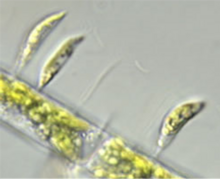| Characium | |
|---|---|

| |
| Characium hookeri | |
| Scientific classification | |
| Clade: | Viridiplantae |
| Division: | Chlorophyta |
| Class: | Chlorophyceae |
| Order: | Sphaeropleales |
| Family: | Characiaceae |
| Genus: | Characium A.Braun in Kützing, 1849 |
| Type species | |
| Characium sieboldii A.Braun | |
| Species | |
|
See text | |
Characium is a genus of green algae in the family Characiaceae. It is very commonly found in freshwater habitats, where it is attached to phytoplankton or zooplankton.
Description
Characium consists of single or rarely clustered cells. They are attached to a plant or animal substrate (thus epiphytic or epizoic), via a stalk or a circular pad. The cells have diverse shapes, ranging from fusiform to club-shaped or spherical, and are variously straight, hooked, or S-shaped. Cells usually contain a single parietal chloroplast filling the cell, with a central pyrenoid. In some species, the chloroplasts fragment into multiple plastids, each with one pyrenoid. Mature cells have one nucleus (are uninucleate).
Characium reproduces asexually by zoospores. Zoospores have two flagella.
Identification
The genus Characium is similar to Characiopsis, a type of algae in the class Eustigmatophyceae. The two genera are very similar and have been confused in the past; however, Characium produces starch to store excess carbon and thus stains brown to purple in Lugol's iodine solution, while Characiopsis does not. Many other similar segregate genera have been named. These include Deuterocharacium, which differs in having chloroplasts without pyrenoids, and Characiopodium, with multinucleate mature cells.
Identification of species depends on the shapes and sizes of the cell body, as well as the stipe with which the body is attached.
Species list
- C. acuminatum
- C. ambiguum
- C. angustum
- C. astipitatum
- C. braunii
- C. bulgariense
- C. cerassiforme
- C. conicum
- C. epipyxis
- C. giganteum
- C. groenlandicum
- C. guttula
- C. heteromorphum
- C. limneticum
- C. marinum
- C. nasutum
- C. obtusum
- C. ornithocephalum
- C. ovale
- C. polymorphum
- C. prodani
- C. pseudopyriforme
- C. pyriforme
- C. rostratum
- C. saccatum
- C. sieboldii
- C. strictum
- C. substrictum
- C. subulatum
- C. tenue
- C. terrestre
- C. urnigerum
- C. westianum
References
- ^ Guiry, M.D.; Guiry, G.M. "Characium". AlgaeBase. University of Galway. Retrieved 2023-09-26.
- Shubert, Elliot; Gärtner, Georg (2014). "Chapter 7. Nonmotile Coccoid and Colonial Green Algae". In Wehr, John D.; Sheath, Robert G.; Kociolek, J. Patrick (eds.). Freshwater Algae of North America: Ecology and Classification (2 ed.). Elsevier Inc. ISBN 978-0-12-385876-4.
- ^ Bicudo, Carlos E. M.; Menezes, Mariângela (2006). Gêneros de Algas de Águas Continentais do Brasil: chave para identificação e descrições (2 ed.). RiMa Editora. p. 508. ISBN 857656064X.
- ^ Ettl, Hanuš; Gärtner, Georg (2013). Syllabus der Boden-, Luft- und Flechtenalgen (in German) (2nd ed.). Springer-Verlag. ISBN 9783642394614.
- Guiry, M.D.; Guiry, G.M. "Characiopsis". AlgaeBase. University of Galway. Retrieved 2023-09-26.
- Matthews, Robin A. (2016). "Freshwater Algae in Northwest Washington, Volume II, Chlorophyta and Rhodophyta". A Collection of Open Access Books and Monographs. Western Washington University. doi:10.25710/fctx-n773.
- Guiry, M.D.; Guiry, G.M. "Deuterocharacium". AlgaeBase. University of Galway. Retrieved 2023-10-09.
| Taxon identifiers | |
|---|---|
| Characium | |
This Chlorophyceae-related article is a stub. You can help Misplaced Pages by expanding it. |